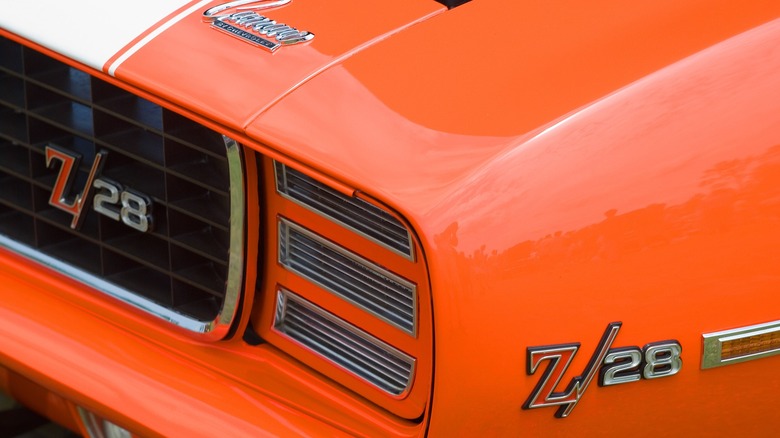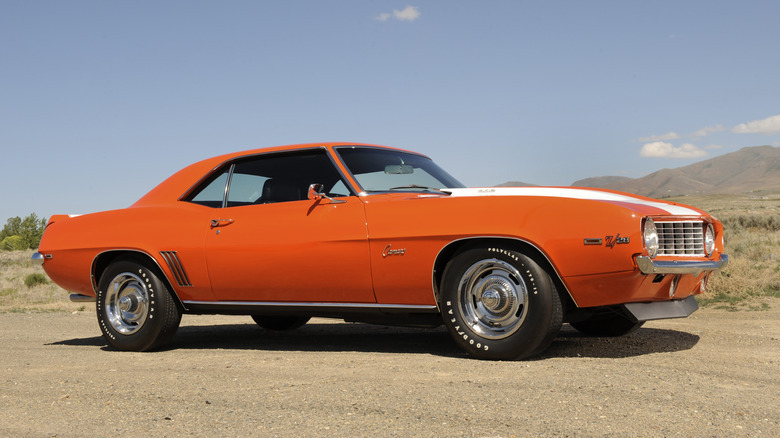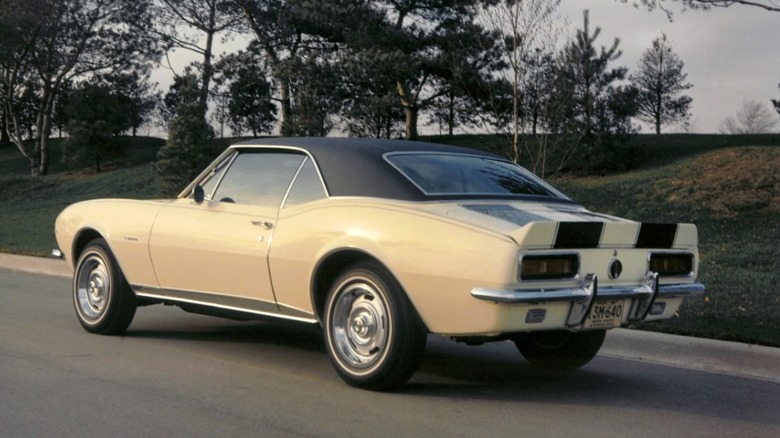This Chevy Small-Block Engine Gave The Camaro Its Street Cred
At the height of the muscle car and pony car wars in the mid-to-late 1960s, Detroit's Big Three automakers were solidly in contention over which could lay claim to the largest displacement V8. Heck, the movement even spawned its own expression: "There's no substitute for cubic inches." Well, Chevy's 1967 to 1969 Z/28 Camaro proved that phrase to be false.
The fledging Camaro's Z/28 option package was the creation of a performance-obsessed Chevrolet executive named Vince Piggins, who envisioned a race-ready Camaro that customers could buy off the showroom floor. A well-balanced vehicle that could not only hold its own in straight-line drag races, but could rip around a set of curves with aplomb, basically showing Ford's Mustang who's boss.
Since Chevy intended the Z/28 to race in the SCCA's newly introduced Trans-Am series (namesake of the Pontiac Trans-Am), the size of the engine was restricted to a maximum displacement of 5.0 liters per the SCCA rules. To accomplish this, Chevy paired the engine block from its 327 cubic inch V8 with the crankshaft from a 283 cubic inch V8, resulting in a total displacement of 302 cubic inches or its metric equivalent of 4.9 liters.
[Featured image by DeusXFlorida via Wikimedia Commons | Cropped and scaled | CC BY 2.0]
It could rev to the moon
The large-ish 4-inch bore of the 302 eclipsed its short 3-inch stroke, resulting in what's known as an oversquare design that was capable of revving to very high RPMs — approximately 7,000 rpm in an era where lazy big-blocks were lucky to rev past 5,500 or 6,000 rpm.
But high revs weren't the only weapon in the 302's arsenal. It was also fitted with a camshaft (often considered the mechanical "brain" of the engine) developed by famed engineer Zora-Arkus Duntov, cylinder heads lifted from a fuel-injected Corvette, and a high-rise aluminum intake manifold with a big 780 cubic feet per minute (cfm) Holley carburetor.
For durability, all of the internal components were forged steel as opposed to the weaker casting method of construction. Chevy conservatively rated the Z/28 at 290 horsepower, but subsequent independent dyno testing indicates that figure was more than 350 horsepower in reality.
It conquered the Trans-Am racing series
Besides its signature engine, the Z/28s also came equipped with front disc brakes rather than drums, heavy-duty suspension, 15-inch diameter wheels (which was considered large at the time), and a special hood with cold air induction. Early Z/28 owners had no alternative but to row their own gears because a close-ratio four-speed manual was the only transmission available.
On the road racing track, the Z/28 hit its mark, winning the SCCA Trans-Am Championship in both 1968 and 1969 at the hands of legendary drivers like Mark Donahue and George Follmer. It was slightly less successful on the drag strip, where Road & Track tested a 1968 model and ran a 14.9-second standing quarter-mile. That's about one full second slower than the top muscle cars of the era, but admittedly, those cars were more singularly fixed on straight-line performance.
Later in the production cycle, Chevy offered Z/28 owners an optional cross-ram intake manifold, fitted with two Holley 585-cfm carburetors. Available over-the-counter or as a dealer-installed accessory, the exotic-looking dual-carb intake was said to provide a 25 horsepower boost, but at a cost of approximately $500 which is the equivalent of more than $4,000 today. When the Camaro was completely redesigned for the 1970 model year, the Z/28's 302 went away in favor of a more plain-vanilla 350 cubic inch V8 which produced greater horsepower than the outgoing car, but couldn't match the high-revving, durable, and truly unique nature of the 302 engine.


